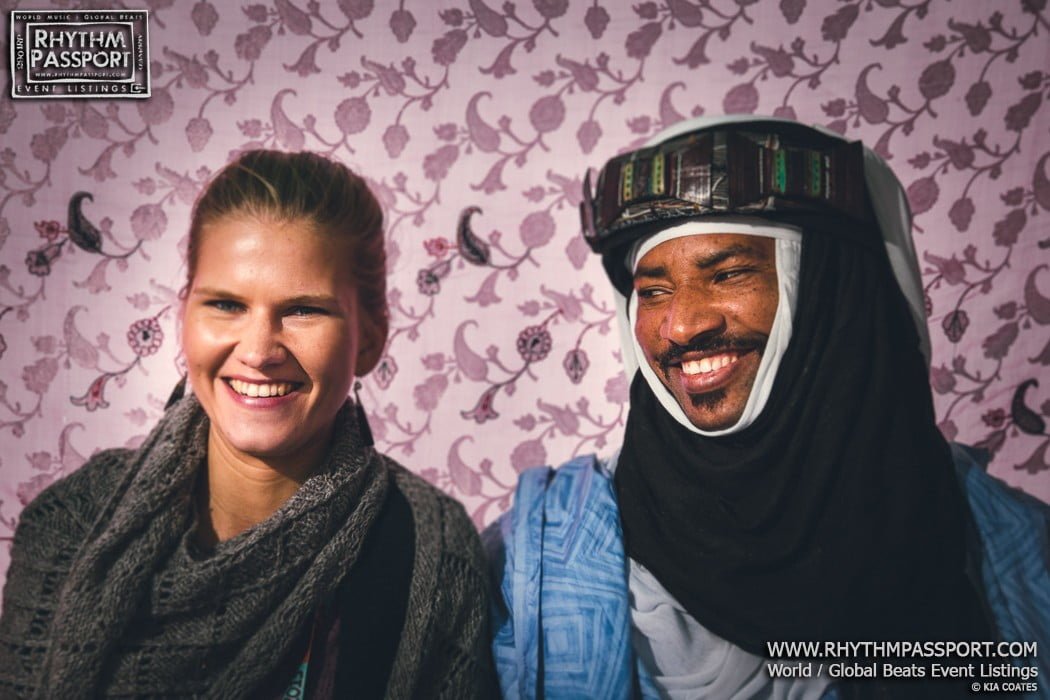Cross-cultural collaborations are a big thing at WOMAD, and 2015 was no exception. Today we talked to a most unusual pairing of desert blues fused with the folk traditions of the chilly Baltic. Etran Finatawa guitarist, percussionist and vocalist Alhousseini Anivolla from Niger teamed up with fiddler and singer Maarja Nuut from Estonia in this intriguing collaboration. We managed to catch up with them after their Sunday afternoon show on the BBC Radio 3 Charlie Gillett Stage for a short interview, and we began by asking how they first met and started playing together. Maarja explained:
We met a year ago – almost exactly a year back – in Estonia. Alhouss and his band Etran Finatawa were coming to play at the Viljandi Folk Music Festival – a really nice big festival. They came a bit more than a week before and there was the possibility that they would collaborate with a local musician, so I was the volunteer to go there – and so we met!
So Alhousseini, how did the project progress after that initial meeting?
After that I went back home to Niger for a bit, then I had another residency in Estonia in January 2015 for a week with Maarja, sponsored by the folk music centre in Viljandi, and then we did two concerts in Tallin & Viljandi in January.
The duo’s trip to the UK came about through the link between WOMAD and the group Etran Finatawa, which Alhousseini now leads and with whom he has done many previous WOMAD shows. Their manager Sandra van Edig told WOMAD about Maarja and Alhousseini’s collaboration and asked if they’d be interested in this exchange between friends – and they were!
So now they were both here at WOMAD we were interested to find out how it feels to collaborate when musicians are from traditions so far apart both geographically and culturally. Maarja was keen to explain about the collaboration process from her perspective.
There are some things that we have in common that draw us to one another. Then there are, of course, some really tricky things. The culture is different, the music is different, so it’s not so easy to put it all together. It’s really a challenge! Being an ethnomusicologist and working with music theory I can say that there’s a different way of phrasing and different rhythms – we mainly count in three and they mainly count in two, so that can be the first clash where things just don’t meet up! The modes as well are different. The similarity is that both traditions have their own modes and scales – but they’re not the same ones! But you can find a way through it.
And how was it for Alhousseini? We asked if he knew anything about Estonian traditional music before he came to collaborate with Maarja.
No. I’d never heard Estonian music. It was the first time at the festival in Estonia. It was through Maarja that I discovered Estonian music.
We asked Maarja what features of her traditional music she was able to combine with Alhousseini’s desert sounds and how she went about selecting what material to use in the arrangements.
Well, I’ve listened to his style of music a lot, which helps. Originally I play traditional Estonian music. There is instrumental music mainly for dancing and a different tradition for singing. The songs that I played today for example were traditional. The newer tradition of instrumental music is more structured, but personally I play more of the older style, which is kind of more open. But yes, there is a big difference between our music sometimes and I would probably become really frustrated if I were trying to teach him an Estonian tune with the structure, so when I play violin then it’s more like trying to find a way to fit with Alhouss’s sound.
Alhousseini adds:
…and of course we had to improvise quite a lot because we didn’t really have much time to rehearse.
So then we asked Alhousseini what the main differences were between the two types of music for him, and received a most poetic response:
The main difference is that the music I play is about the wind and the air. This is the foundation of our music. The sound comes from the breeze caressing the sand. Our music is about gentleness, tranquility. That’s the difference between certain other traditional musics. The Estonian music sounded quite brutal in a way when I first heard it. But that’s not a problem! Music has no frontiers so you can always find a way through
So in the end Alhousseini and Maarja both agree that despite the differences between their musical cultures there is always a solution, and this is what defines a good collaboration. We wish the pair good luck with their project and look forward to hearing more from this fascinating duo in times to come.


